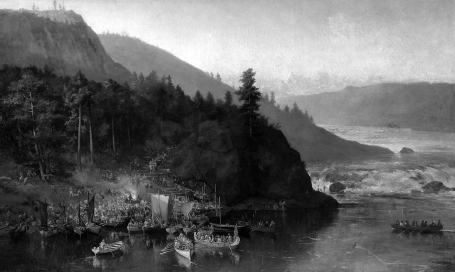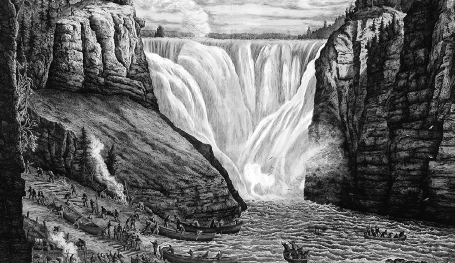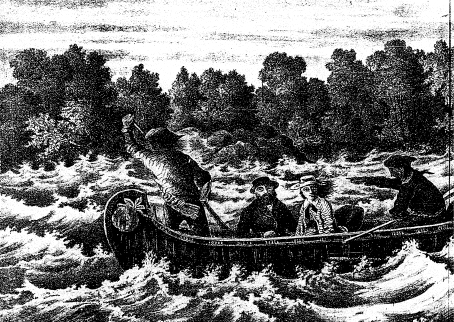
In the spring of 1870, the Red River Expeditionary Force drew huge crowds — at the Crystal Palace in Toronto, at the wharf in Collingwood, at Camp Sault, and at Prince Arthur’s Landing. Among those who came out “to see the troops” were three artists whose photographs, sketches, and paintings represent the bulk of the expedition’s visual documentation.
On June 10, the Globe’s Sault Ste. Marie correspondent said the Waubuno arrived from Parry Sound with “a photographer from Guelph” named D.F. Macdonald. According to the reporter, Macdonald took a general survey of the area and then some specific “views” of the grounds, the tents, and other “objects of interest.” One “view,” the reporter judged “particularly capital,” was of a group of officers gathered in front of Major Acheson Gosford Irvine’s tent.
Macdonald was born in West Flamborough, Canada West, and moved to the Parry Sound district in 1867. There he worked for the Crown Lands Department as a wood ranger, timber cruiser, and eventually Crown timber agent. Much later, he was appointed local Indian agent for the district. Macdonald was also an avid diarist and photographer. The Archives of Ontario contain a small trove of his records, including photographs of the expedition taken at Sault Ste. Marie: the “capital view” of the officers in front of (presumably) Major Irvine’s tent, two views of the camp, one shot of expedition teamsters at breakfast, another (presumably) of their camp, and one of an unnamed soldier enjoying a pipe. With one exception, Macdonald’s are the only known pictures of the expedition from Sault Ste. Marie.
The Globe said that Macdonald intended to accompany the expedition “at least to Fort William,” and the “views” and sketches he planned to take “will no doubt command a large sale throughout the country.” There is no record of Macdonald proceeding to Thunder Bay.
For decades a woman was rumoured to have accompanied Colonel Wolseley and his expedition to Red River. Most assumed it was British painter Frances Anne Hopkins, given her legendary travels through Rupert’s Land in the 1860s with her husband, HBC superintendent Edward Hopkins. Based on personal diary entries, Alice Johnson, long-time archivist of the Hudson’s Bay Company and assistant editor of its Record Society, says Hopkins was back in Britain with her husband and children by the middle of July 1870. Nevertheless, Johnson maintains that Hopkins did travel to Prince Arthur’s Landing in June 1870 with her friend, Louisa Wolseley, the colonel’s wife. It was during this trip, Johnson says, that Hopkins most likely visited the portage around Lower Kakabeka Falls on the Kaministiquia River, which is depicted in one of the most famous paintings of the expedition, The Red River Expedition at Kakabeka Falls.1

The Red River Expedition at Kakabeka Falls (1877) by Frances Anne Hopkins.
Perhaps Louisa Wolseley and Frances Anne Hopkins were the “two ladies” St. John said arrived at Prince Arthur’s Landing aboard the Chicora on June 3, 1870. According to him, “There is little or no accommodation here for ladies, and those are venturesome who come up unless on invitation.” On June 9, St. John (and presumably Ranoe) boarded the Okonra with the ladies and “a large party of officers” and “steamed over to the Kaministiquia.” St. John described the day like this in the Globe of June 15, 1870:
It was a bright, clear summer afternoon, and the river, with its banks of variegated green and silver beech — its dark reaches, from which no opening could be seen — and its great grim neighbour Mount McKay, towering above and frowning over the stream…. Mile after mile was passed as the Okonra steamed on; and there, where to preserve the harmony of the scene, only noiseless canoes and silent Indians should have been found, our noisy little tug lashed the river into foam, and spirited streams of water from her side, while her living freight laughed and talked, waking the echoes of the mountain with the ring of their voices, mingling expressions of admiration for the scene, with congratulations at the absence of mosquitoes.
We all landed at Point Muro, the Okonra going alongside the bank of the river, and walked across to see the rapid. I don’t think any of the party saw it, for we kept too far down; but instead of the rapids we came across a colony of mosquitoes and blackflies.
Cunningham reported ladies at Prince Arthur’s Landing, as well. At the June 25 boat race between the Ontario Battalion’s Company No. 5 and the Royal Engineers, “all the ladies” for 10 miles around were invited. “There are not very many ladies about,” wrote Cunningham in the Telegraph of July 1, 1870, “but those that are, are very pretty and exceedingly interesting.”

Kakabeka Falls on the Kaministiquia River (1871) by William Armstrong.
Johnson says Hopkins and Louisa Wolseley returned to Montreal with Lieutenant General James Lindsay in early July 1870.
On board the Chicora on June 3, 1870, was a photographer whom St. John said proposed to “accompany the expedition and take a series of views along the route.” The man was still in camp on June 11, but by then “everyone about the place” was asking “when is he going to begin? We all want photographs of the camp, the bay, the Indians, and of everything in general, to send to our friends.” By June 15, the photographer was gone, prompting St. John to ask: “Is there not in Toronto a photographic establishment sufficiently enterprising to send an artist up who will take views of the camp and Thunder Bay, and accompany the expedition to Red River?”
The photographer could have been Toronto-based painter and photographer William Armstrong, the most prolific documenter of the expedition. At least 13 of his expedition sketches appeared in Canadian Illustrated News, including Kakabeka Falls and Portage, which served as the basis for his most famous expedition rendering, Kakabeka Falls on the Kaministiquia River. For years there had been rumours that Armstrong had served with the expedition. His obituary said he was “chief engineer” with the “63rd Regiment” in charge of getting “the troops to negotiate the rivers and lakes of northwestern Ontario.”2 While Armstrong might have been the photographer St. John reported in Prince Arthur’s Landing in June 1870, the Globe had Armstrong back in Toronto by June 18 selling paintings.3
One of Armstrong’s most intriguing works from this period is Mr. and Mrs. St. John Running the Rapids, Sturgeon River. In November 1871, the Canadian Illustrated News published one of Armstrong’s drawings to commemorate “a daring adventure on the part of a lady who pluckily accompanied her husband throughout the Red River expedition” and helped promote Ranoe’s lecture tour for “The Great North-West.” The drawing was entitled Mr. and Mrs. St. John Running the Rapids, Sturgeon River and was the basis for Armstrong’s 1871 painting of the same name.

Kate Ranoe and Molyneux St. John running the rapids on the Sturgeon River in Northern Ontario.
What inspired Armstrong to make the drawing? In the absence of any hard evidence, I suggest the following: If Armstrong travelled to Thunder Bay to visit the expedition in June 1870, there is a good chance he met St. John and Ranoe — and was charmed by them and their story. And given the popularity of “The Great North-West” and Armstrong’s interest in the expedition, there is an equally good chance that Armstrong attended Ranoe’s lecture in Toronto in May 1871. Who knows exactly, but Ranoe did write one particularly dramatic account of running rapids on the Maligne River just past Sturgeon Lake (Globe, August 15, 1870), recounted in chapter 13, “Intellectual Characters.” It certainly would have added suspense and excitement to her lecture, perhaps enough to inspire Armstrong.